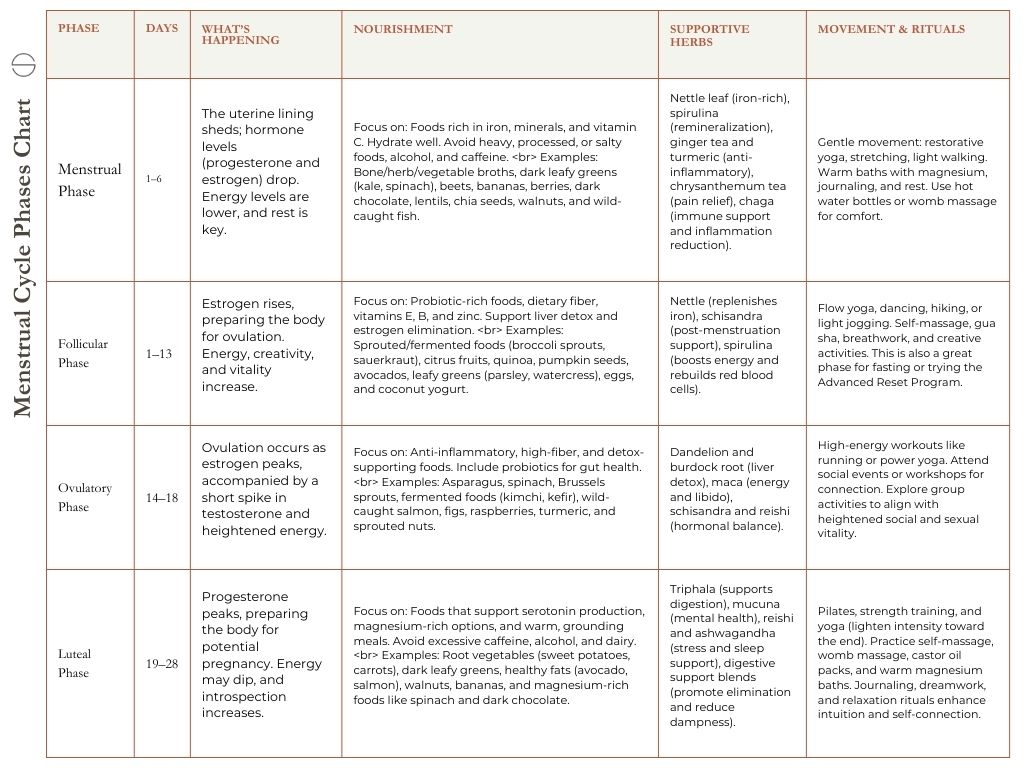
DIY Natural Toothpaste & Tooth Powder – Featuring Pearl Powder
A clean, effective way to care for your teeth, without

Kick-start, energise, rejuvenate
All carefully planned and prepared to help nourish, reset and rejuvenate the body and mind.

Nature operates in a rhythmic pattern of cycles, demonstrating the intricate dance of life. The changing seasons cycle from winter’s chill to spring’s renewal, through the warmth of summer, and into the colourful tapestry of Autumn. The moon itself cycles from the quiet new moon to the radiant full moon, then back to its gentle beginning.
As women, we embody a multitude of cycles within us, encompassing various aspects of our being. These cycles range from the daily rhythms of sleep and heartbeats to the more pronounced and profound menstrual cycles. In particular, for menstruating women, the monthly journey unfolds in four distinct phases. Much like tending to your body differently in response to shifting seasons, it is equally vital to provide support and care throughout each phase of your menstrual cycle.
This ongoing cycle of self-love and self-care serves as the cornerstone for achieving hormonal equilibrium within our bodies. The rewards of balanced hormones extend far beyond fertility enhancement and PMS symptom reduction; they ripple through our overall health and vitality. Our bodies thrive when we function at our prime, as they instinctively prepare for reproduction.
In conjunction with daily nourishment through wholesome foods and physical activity, achieving internal balance involves cherishing and assisting yourself through each stage of your cycle. This approach is a means of nurturing the most intimate relationship you will ever have – the one with yourself. By dedicating yourself to self-care with deep respect and joy, you radiate harmonious femininity throughout your entire life.
Incorporating herbal remedies that promote restoration and equilibrium can further support your body’s wisdom.
If you require direction, reach out to a holistic health practitioner who can offer expert assistance tailored to your unique needs.

OUR CYCLES IN GLANCE
The menstrual cycle unfolds in two primary phases: the follicular phase and the luteal phase. Nested within these are two additional phases, namely menstruation and ovulation.
Commencing with the first day of your menstrual cycle, which marks the onset of menstruation, the follicular phase extends until approximately day 14-16, culminating in ovulation. Subsequently, the luteal phase takes the reins and spans from approximately day 15 to day 28, heralding the arrival of your next menstrual period. These phases are orchestrated by natural hormonal fluctuations in the body, making the condition of our menstrual cycles a reflection of our hormonal health.
The hormonal ebb and flow during the menstrual cycle are orchestrated by an ensemble of hormones. When these hormones veer off balance, women may encounter a spectrum of symptoms. By embracing a regimen of balanced nutrition, herbal support, and supplementation, we can foster harmony within our bodies and hormones, mitigating these symptoms and cultivating a healthy, regular menstrual cycle.
Throughout all phases of the cycle, it is crucial to provide our bodies with nourishment from whole, unprocessed foods, while concurrently limiting or avoiding the following:

MENSTRUAL (day 1-6)
This phase of your menstrual cycle initiates on the first day you experience menstrual bleeding, marking day one of your cycle. Typically, this phase lasts anywhere from 3 to 6 days in a healthy individual. During this time, when the body recognizes that pregnancy has not occurred, hormonal changes unfold to facilitate the shedding of the uterine lining, resulting in menstrual bleeding.
As menstruation commences, the production of progesterone and estrogen drops. Since the primary objective of this phase is to expel the uterine lining, it becomes crucial to provide support for your body during this elimination process.
You might find yourself feeling more fatigued than usual and experiencing cravings, often for foods like chocolate. These cravings are often your body’s way of signaling a need for iron and magnesium-rich foods. It is essential to grant yourself the time required during this phase to rest, recharge, and rejuvenate.
Nourishment for the Menstrual Phase:
Opt for foods rich in minerals, iron, and vitamin C. Ensure adequate hydration. Conversely, avoid heavy and fatty foods, alcohol, red meat, excessive caffeine (especially coffee), and highly processed or excessively salty foods during this phase.
Include foods such as bone, herb, vegetable, or miso broth, dark leafy greens like collards, kale, spinach, and Swiss chard, beets, broccoli, bananas, dark chocolate, nettle leaf, sweet potatoes, seaweeds, berries, avocado, buckwheat, adzuki beans, kidney beans, black beans, lentils, tempeh, nut butter, and Himalayan sea salt. Incorporate omega-3-rich foods like walnuts, wild-caught fish, hemp seeds, and chia seeds.
Supportive Herbs for the Menstrual Phase:
Consider the following herbs and remedies to support this phase:
Movement, Rituals & Remedies for the Menstrual Phase:
Avoid high-impact workouts during this period. Instead, engage in gentle movement as desired, such as stretching and restorative yin yoga, yoga nidra, or light walking. Find comfort in warm baths infused with magnesium and sage, and consider using hot water bottles for soothing relief. Allocate time for rest, reading, and journaling to honour your body’s natural rhythms during this phase.

FOLLICULAR PHASE (day 1-13)
This phase marks the beginning of our body’s preparations for a potential pregnancy, offering a fresh start filled with heightened energy, creativity, and vitality. It’s characterized by a gradual rise in follicle-stimulating hormone (FSH) and increased estrogen levels, leading to an uptick in luteinizing hormone (LH) and the development of multiple follicles, each containing an immature egg. At least one of these eggs will eventually be released during ovulation. This phase presents an opportunity to nurture and support your potential for increased vitality through dietary choices and rituals.
Nourishment for the Follicular Phase:
Incorporate plenty of probiotic-rich foods and sources of dietary fibre, along with foods rich in vitamins E, B, and zinc. Focus on foods that aid liver function and the elimination of excess estrogens from the body, such as cruciferous vegetables. Emphasize the inclusion of sprouted and fermented foods like broccoli sprouts, sauerkraut, and kimchi. Ensuring adequate fibre intake is crucial for the healthy removal of excess estrogen, and options like ground flax seeds and psyllium husk can be beneficial.
Include foods like watercress, parsley, broccoli, leafy greens, avocados, citrus fruits (lemons, limes, oranges, grapefruit), oats, mung beans, lentils, cherries, pomegranates, carrots, zucchinis, quinoa, avocado, pumpkin seeds, pasture-raised organic chicken, eggs, white fish, olives, sauerkraut, nut butter, and coconut yogurt.
Supportive Herbs for the Follicular Phase:
Consider the following herbs to complement this phase:
Movement, Rituals & Remedies for the Follicular Phase:
Engage in activities like flow yoga, dancing, hiking, walking, and light jogging, which are well-suited for this phase. Explore activated breathwork, gua sha, self-massage, and other forms of massage for self-care. Foster social connections and embark on new experiences and activities, as these are particularly beneficial during this time. You’ll likely find your creative energies flowing most freely during the follicular phase, so embrace opportunities for creative expression and innovation.
This is also the best time to practice longer fasting and try our Advanced reset program

OVULATION (day 14-18)
This phase typically occurs in the middle of your menstrual cycle, often around day 14 for most women, although it may vary, especially for those on a 32-day cycle, where it could occur around day 16. Remarkably, the ovulation phase is rather brief, lasting only 24 hours!
It’s essential to exercise caution if you’re not planning to conceive during this phase, as sperm can remain viable in your body for up to five days. Once inside your body, they patiently await the release of the egg from the ovary, which then embarks on its journey to the uterus.
During this window, lasting 1-2 days, we are at our most fertile, accompanied by a peak in estrogen, luteinizing hormone (LH), and follicle-stimulating hormone (FSH). This phase also corresponds with heightened social and sexual vitality. Energy levels surge, and our skin exudes a vibrant and clear radiance, all while we exude an extroverted presence. It’s common to experience a slight increase in body temperature, around 0.5 degrees, during ovulation. For those actively trying to conceive, this presents an ideal opportunity. However, if pregnancy is not in your plans, diligent cycle tracking and precautions during your ovulatory week are advised.
Nourishment for the Ovulatory Phase:
Emphasize foods and herbs that support liver detoxification. Prioritize an anti-inflammatory, high-fiber diet consisting of a variety of fruits, vegetables, and sprouted nuts, alongside an abundance of probiotic-rich foods.
Include foods like asparagus, spinach, Swiss chard, Brussels sprouts, dandelion, figs, coconut, raspberries, dates, apricots, turmeric, quinoa, lentils, almonds, pecans, Brazil nuts, lamb, wild-caught salmon, spirulina, psyllium husks, and fermented foods such as raw apple cider vinegar, sauerkraut, kimchi, kefir, and coconut yogurt.
Supportive Herbs for the Ovulatory Phase:
Consider the following herbs to complement this phase:
Movement, Rituals & Remedies for the Ovulatory Phase:
Engage in higher-intensity workouts like running or power yoga, as they align well with this phase. Attend group activities, workshops, and community events to foster open communication and personal connections. This phase is particularly conducive to attracting potential partners or making new friends.

LUTEAL PHASE (day 14-28)
This phase unfolds immediately after ovulation and is characterized by the breakdown of an unfertilized egg, accompanied by a surge in progesterone levels that subsequently decline when menstruation approaches. This sudden shift in hormonal balance can sometimes give rise to intense or uncomfortable emotions and symptoms. Generally, during this phase, we tend to turn inward. As we progress through this stage, it’s entirely normal for our energy to wane, leading to increased introspection and withdrawal. It’s essential to provide yourself with ample self-care during this period.
Nourishment for the Luteal Phase:
Opt for foods that support serotonin production, including dark leafy greens, healthy fats like salmon, eggs, and avocado, along with sprouted nuts and seeds, as well as root vegetables. Incorporate magnesium-rich foods to boost energy and libido, such as pumpkin seeds, spinach, Swiss chard, and dark chocolate.
Prioritize healthy fats and protein to promote a feeling of fullness and reduce cravings during this phase. Consider reducing or eliminating excessive caffeine, alcohol, and dairy during this time. As you transition into the menstrual cycle, focus on warm, grounding foods, particularly in the latter part of this stage.
Include foods like celery, kale, collards, ginger, sweet potatoes, squash, parsnips, carrots, bananas, apples, dates, pears, brown rice, chickpeas, walnuts. Additionally, include magnesium-rich foods such as spinach, beet greens, celery, Swiss chard, avocados, organic dark chocolate, quinoa, and almonds. Omega-3-rich foods like walnuts, wild-caught fish, hemp seeds, chia seeds, and spirulina are also beneficial.
Stay well-hydrated and incorporate electrolytes as needed, particularly if you tend to experience water retention before menstruation.
Supportive Herbs for the Luteal Phase:
Consider the following herbs to complement this phase:
Movement, Rituals & Remedies for the Luteal Phase:
Engage in Pilates, strength training, and yoga during this phase, particularly in the first half. As you approach the end of this cycle, consider lightening the intensity of your physical activities. Include practices like self-massage, gentle womb massage, yoga nidra, gentle breathing exercises, castor oil packs, warm magnesium baths, and any soothing and comforting activities.
This phase is characterized by heightened intuition. Engage in dream journaling and stream of consciousness writing as powerful tools during this period, extending into menstruation. Try Blue Lotus and Rose for highly engaged conscious practices


A clean, effective way to care for your teeth, without

In the world of tonic herbs and medicinal mushrooms, there’s

As the days grow shorter and the air becomes crisp,
Copyright Shoku Iku © 2024 | All Rights Reserved.
The statements on this website have not been evaluated by the TGA or FDA. These products are not intended to diagnose, treat, cure or prevent any disease.
Sign up to receive your discount.